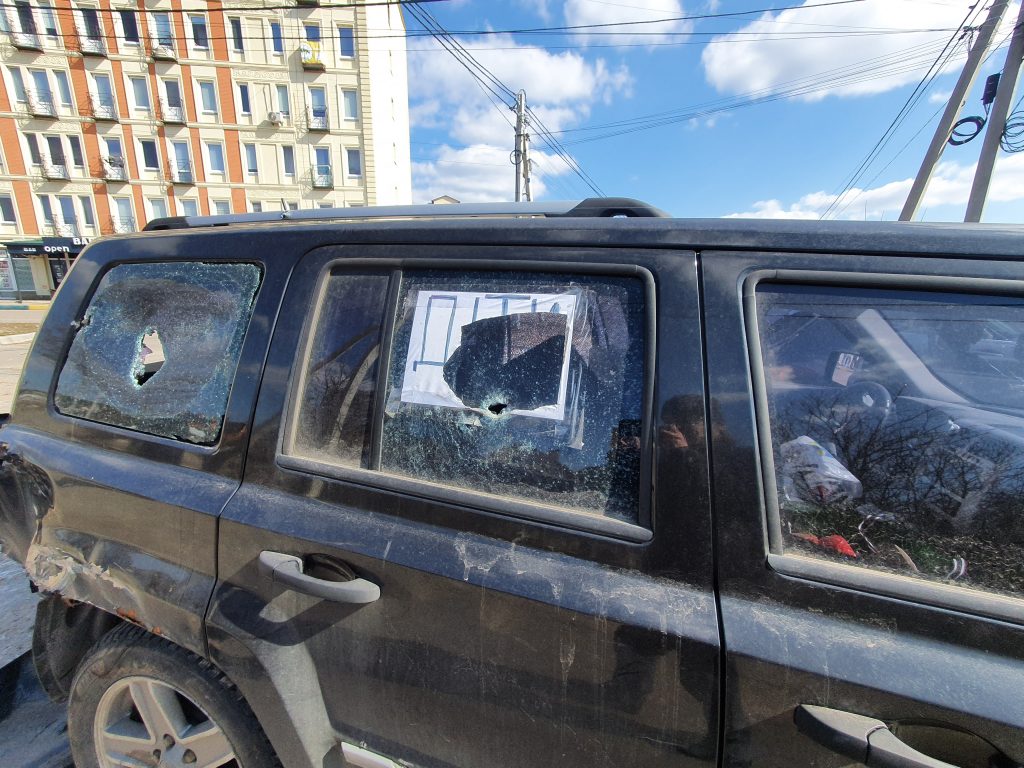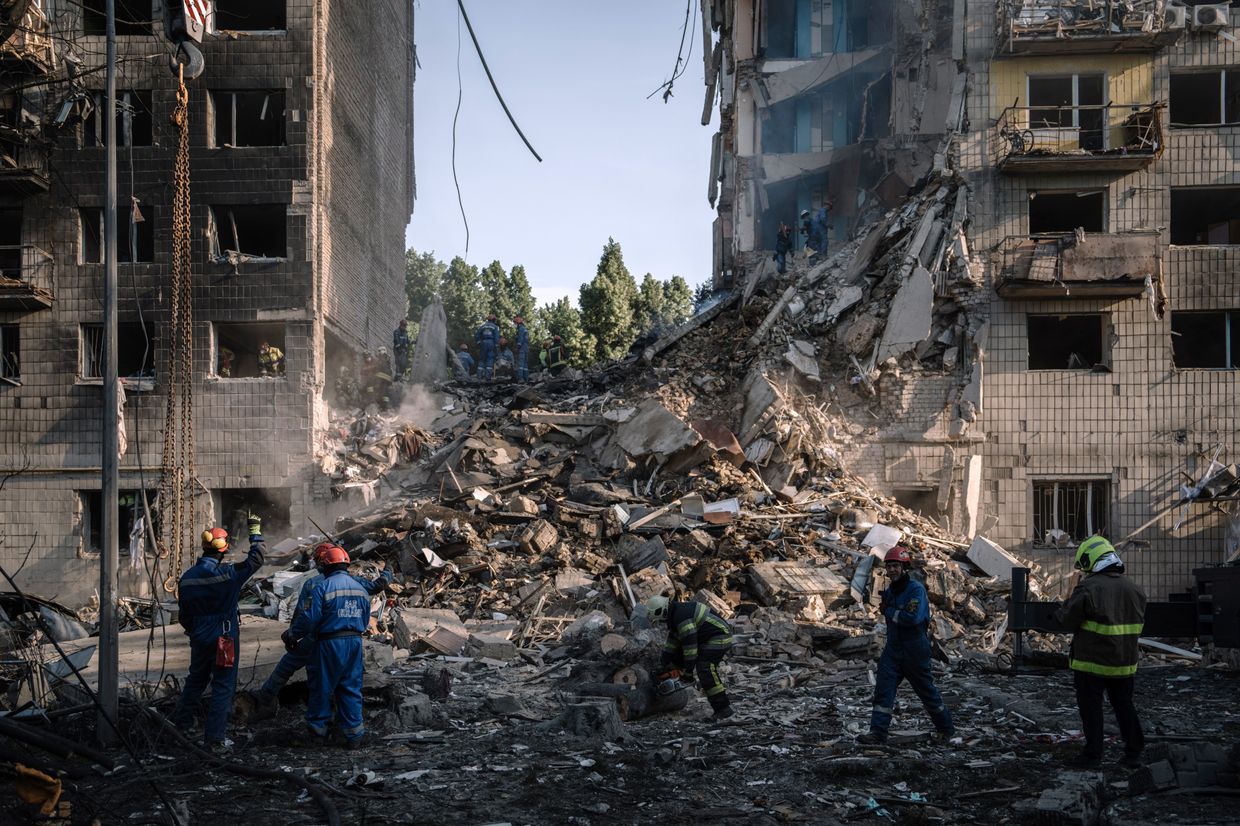STOYANKA-2, Kyiv Oblast – In the village of Stoyanka-2 outside Kyiv, a half-dozen cars line the road, riddled with holes, their bodywork mangled by bullets and an explosion.
Their windows, bearing handwritten Ukrainian signs saying “Children” are perforated or shattered. The suitcases inside the vehicles appear to have been searched. The bodies have been recovered by volunteers or removed by Russian soldiers or locals.
This is what remains of the quarter of a 20-car civilian evacuation convoy that tried to escape the suburban town of Irpin on the morning of March 6. As the convoy entered Stoyanka-2, Russian forces opened fire, most likely from a nearby building, killing at least four people in the first five cars and wounding several more. The rest managed to back up, turn around and flee.
Oleksandr Syrtsov saw it happen directly in front of him.
"I saw with my own eyes how my loved ones were being shot to death... like cannon fodder," he told the Kyiv Independent over the phone from Kyiv. "In 30 seconds, I lost my friend, my cousin, all my things, my documents, my car... all I kept was my life."
The scene, however lurid, drowns in the scores of similar scenes happening around the country. Russian forces throughout Ukraine have fired on fleeing civilians time and again, killing and wounding an unknown amount of evacuees.
On March 23, the Office of the UN High Commissioner for Human Rights reported 977 civilians killed and another 1,594 wounded since Russia invaded on Feb. 24. UNHCR warned that the actual number is most likely "considerably higher."
On the same day as the ambush in Stoyanka-2, Russian forces shelled and mortared evacuees trying to cross the Irpin River several kilometers away, killing eight people.
Trapped in Irpin
A native of Donetsk Oblast, Syrtsov had lived in Irpin, a town just outside Kyiv, for the past two years.
When the war began early in the morning on Feb. 24, Russian forces surged towards the capital and its outlying towns, blasting them with missiles and helicopters and landing troops. The town of Hostomel on Kyiv’s north-western border, which contained an important airfield, was one of the Russians’ first targets. Soon, the devastation spread to the nearby towns of Bucha and Irpin as well.
Syrtsov was trapped in his high rise apartment building, along with the rest of its occupants and his friend, also named Oleksandr. The friend was visiting for work reasons on Feb. 23 and decided to spend the night. The decision would seal his fate.
As shells and missiles slammed into Irpin, the residents of the entire building took shelter in the underground parking garage, which at one point was filled with 200 people. Even though it was perpetually cold down there, the first few days weren’t so bad. The building had electricity and amenities. Later, access to utilities was severed. People were left in the dark, with no gas, no mobile internet connection and dwindling supplies.
People kept leaving every day but many were too worried to go and remained behind. Eventually, they realized they couldn’t keep it up any longer.
“On the evening of March 5, everyone prepared for it, knowing they would leave the next morning because staying was becoming untenable,” said Syrtsov. “There was no electricity or water, our complex got shelled many times, the situation was critical, food was running out. There were small children.”
The kill zone
The convoy of 20 cars set out on their journey at 7:30 a.m. on March 5. As the direct bridge to Kyiv had been blown earlier, they would have to go the long way around, through the villages of Stoyanka and Stoyanka-2. They passed a Ukrainian checkpoint, where the troops cleared them to proceed after checking everybody’s documents.
“No one among the Ukrainian troops guessed that there might be an ambush waiting,” said Syrtsov.
He was driving one of the cars, a BMW, with a married couple as passengers. His friend Oleksandr was driving an Audi, with Syrtsov’s cousin Artyom Podkopayev in the front passenger seat, and Podkopayev’s wife and four-year-old son in the back.
The morning was dead silent, eerily so, as the vehicles slowly drove around the remnants of a Russian combat vehicle in the road and approached Stoyanka-2, stopping within 200 meters. Everybody was nervous to proceed. Eventually, Syrtsov's friend stepped out of the car and asked who would go first.
The group hesitated, with several people saying that they have children. Eventually “my friend waved his hand, got in the car and went first,” said Syrtsov.
With Oleksandr in the lead, the first five vehicles slowly accelerated to about 15 kilometers per hour, crawling past several tall buildings to the left of the road. Syrtsov, in vehicle number six, began to follow.
The thump of automatic fire shattered the morning stillness.

The impacts seemed like firecrackers being thrown at and under the cars, Syrtsov said. He didn’t know who was shooting. He guessed the fire probably came from one of the buildings to the left. However, when later examined, the struck vehicles also showed indentations on their right side. Syrtsov's car was also hit but not as hard as the first five.
“The first five cars went forward and I was in the sixth, I hit reverse,” he said. “I paused for three seconds, ducked down, saw with my own eyes how the cars were being shot apart and reversed about 70 meters.” He hit some other vehicle, loaded with bread, that was pointed in the opposite direction.
"It happened so quickly," he said. "In that moment, my fear was very intense, but there was an understanding that my life might end here. I didn't scream or freak out, I just did everything automatically to try to save my life."
Going in reverse saved him. The remaining evacuees’ vehicles began to turn around to head back to Irpin and they picked him up. Though Syrtsov had spent over a week with no mobile connection, his phone caught a signal in the kill zone. Fifteen seconds later, he got a call from Iryna Podkopayeva, the wife of his cousin Artyom, who was in the lead car.
“She tells me Artyom is killed, Sasha is killed, I’m in the car, what do I do?” said Syrtsov. “She called me right from the car. I told her to come out and head this way. If it’s your fate, you will live. Or something like that.”
Inside the first car
Podkopayeva recalled that moment in a phone call with the Kyiv Independent.
“It sounded like many petards, a sort of ‘tuktuktuktuk,’” when the shooting started, she said. “And then it seemed to me like the car just crashed – I later found out that it was a grenade exploding on the driver’s side. Then there was shooting. Last thing I remember is that the guys raised their hands to surrender.”
Her husband yelled to her to hide the kid, whom she grabbed and crushed to her body with all her strength. Terrified by the explosions, the boy began screaming and crying.
The window shattered, sending fragments skipping across her face and ear. Then the gunfire abruptly stopped. The car was filled with smoke.
“I opened my eyes to see what was happening. The driver was… that’s it.”
The driver was slumped over, the nose missing from his face.
“My husband was lying on the ground, covered in blood. He was convulsing.”
Iryna struggled to remember how to move the seat forward in the small coupe, before managing to grab the purse with her documents and come outside with her son. Wrapping him in a blanket, she wandered forward in a state of shock, going in the opposite direction from Irpin.
Soon, she blundered into a Russian checkpoint, where Russian soldiers took her and her child into a nearby building and got them some water.
“I hadn’t even realized that they were the ones who were shooting at first but then I pieced it together,” she said.
Twenty minutes later, she was placed in a random car with some other survivors – a man and his two children, whose wife had been killed in the shootout – and they were sent on their way. Eventually she ran into some Ukrainians, who helped her and her son make it into Kyiv. She has since evacuated the country.
Death toll
Syrtsov is aware of at least four people who have been killed and several others who were wounded in the shootout.
He and the occupants of the rear 15 cars went back to their parking garage. The only other way out for them was to leave their cars behind and cross the Irpin River under the demolished bridge, across some wooden planks and pallets the Ukrainian forces laid down.
But that route was not an option on March 6. As many civilians tried to get out that way, the crossing came under intense Russian mortar fire, putting evacuation on hold and killing eight people.
One shell killed an entire family, including a mother, two children, and a family friend, according to multiple journalists on site, who saw it happen. Eyewitnesses told the Kyiv Independent that the barrage of the crossing was very heavy that day.
Several volunteers who operate in Irpin made contact with Syrtsov after seeing his family’s story on Instagram and volunteered to evacuate the bodies of Oleksandr and Podkopayev from Stoyanka-2.
Their bodies, recovered from next to the stricken Audi, were sent to Dnipropetrovsk Oblast, where Syrtsov’s friend Oleksandr is from. The funeral was held on March 20.
“It’s a tragedy. They were so young, they could have lived and lived,” said Syrtsov.
Stoyanka-2 remains a battleground, with rare periods of calm amid frequent fighting and shelling, according to the Kyiv Independent’s sources in the area.













